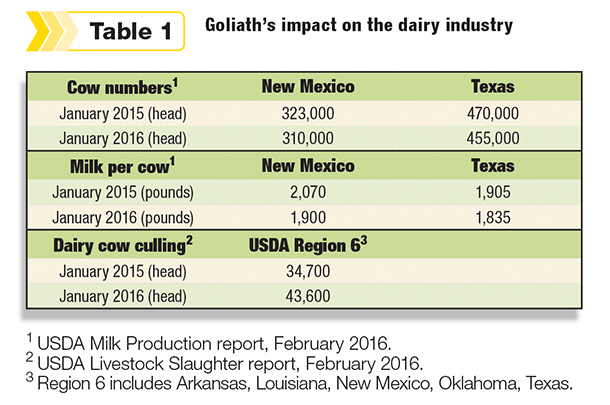It'll take months or longer to determine the full physical and financial impact Winter Storm Goliath had on Texas and New Mexico dairy herds, but the numbers are starting to show.
Cow numbers
USDA’s monthly milk production report, with estimates of milking and dry cows and milk produced per cow for January 2016, represents the first “official” numbers reflecting Goliath’s impact, according to Bob Cropp, University of Wisconsin – Madison professor emeritus.
“I think they could adjust it some more,” Cropp said.
Some estimates put the immediate cow death loss at about 30,000 head in the West Texas and eastern New Mexico area as a result of the late-December 2015 storm.
New Mexico
Based on January 2016 USDA estimates, New Mexico’s cow numbers were down 9,000 (2.8 percent) from December 2015 and 13,000 head (4 percent) less than January 2015 (Table 1).
Milk production per cow declined more than 8 percent compared with a year earlier, from 2,070 pounds in January 2015 to 1,900 pounds in January 2016 (Table 1). With fewer cows and less milk per cow, New Mexico’s overall January 2016 milk production declined 12 percent compared with the same month a year earlier.
New Mexico's dairy herd has been in a fairly narrow range of 321,000 to 330,000 head since 2007. With the impact of Goliath, based on January 2016 data, New Mexico’s dairy herd would be the smallest for any month since October 2002.
And, at 1,900 pounds of milk per cow, it's the lowest for any January since 2008.
Texas
The numbers in Texas tell a similar story. January 2016 cow numbers in the Lone Star State were down 6,000 (1.3 percent) from December 2015 and 15,000 head (3.2 percent) less than January 2015 (Table 1).
Milk production per cow declined about 3.7 percent compared with a year earlier, from 1,905 pounds in January 2015 to 1,835 pounds in January 2016 (Table 1). With fewer cows and less milk per cow, overall January 2016 milk production in Texas declined 6.7 percent compared with the same month a year earlier.
The dairy herd in Texas has been on a growth curve. However, with the impact of Goliath, January 2016’s herd would be the smallest for any month since March 2014. At 1,835 pounds, milk per cow would be the lowest for any January since 2010.
In a letter to U.S. Ag Secretary Tom Vilsack, in mid-January, Darren Turley, executive director of the Texas Association of Dairymen, estimated 10 percent of mature cows in the West Texas area might have been killed in the storm. The region contains five of the state’s top 10 milk-producing counties – Bailey, Castro, Deaf Smith, Lamb and Parmer – and is home to about 36 percent (142,800) of the state’s dairy cows. The number of calves and heifers killed had not been determined.
Beyond counting cows
Bob Matlick, with California-based Frazer LLP, an accounting firm with dairy clients from Texas to the Pacific Northwest, said Goliath's impact is showing up in herd health events, leading to cow culling.
“There's a tremendous amount of mastitis,” Matlick said. “It may have reached its peak, but we're going to see more. Texas is looking for milk because a lot of cows are being culled as a result of storm damage. I have clients tell me the total impact will be 130,000 to 150,000 cows. Another client told me it was a ‘$1 million storm’ for every producer.”
USDA’s January 2016 ag prices report estimated quarterly average replacement cow prices were $1,850 per head in Texas and $1,900 per head in New Mexico.
Boots on the ground
Paul R. Biagiotti, DVM, Basin Bovine Practice, Jerome, Idaho, consults on a large New Mexico dairy. After a personal trip to observe the devastation, he explained what he has witnessed in the weeks after Goliath. He believes it is representative of other dairies impacted by the storm.
“Milk quality took the biggest hit,” Biagiotti said. “Clinical mastitis incidence increased to over 20 percent for January. There has been an increase in Staph. aureus infections, which is no surprise, given the severe teat-end damage. Somatic cell counts (SCC) went from 200,000 cells per milliliter (c/mL) to over 2 million c/mL, and have only just returned to normal. Herd removals in the first 60 days in milk (DIM) have increased, as has the abortion rate.”
Culling numbers rising
Those health issues are being revealed in USDA dairy cow culling reports.
USDA’s weekly and monthly cow culling estimates provide regional information, but not individual state data. New Mexico and Texas fall in USDA's Region 6, which also includes data for Arkansas, Louisiana and Oklahoma.
January 2016 cow slaughter data for Region 6 shows dairy cow culling totaled 43,600 head, a jump of nearly 9,000 head (26 percent) compared with the 34,700 head culled during January 2015 (Table 1). The region's dairy cow culling averaged 30,150 per month for all of 2015, up from 26,190 per month in 2014. PD





